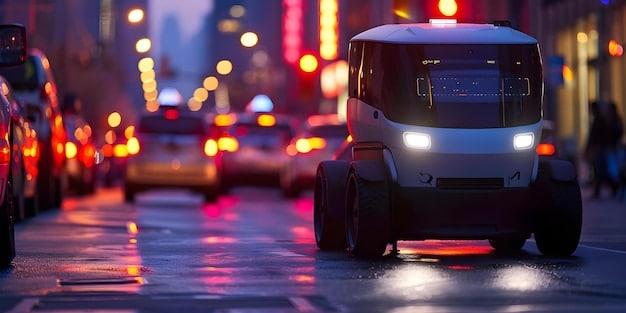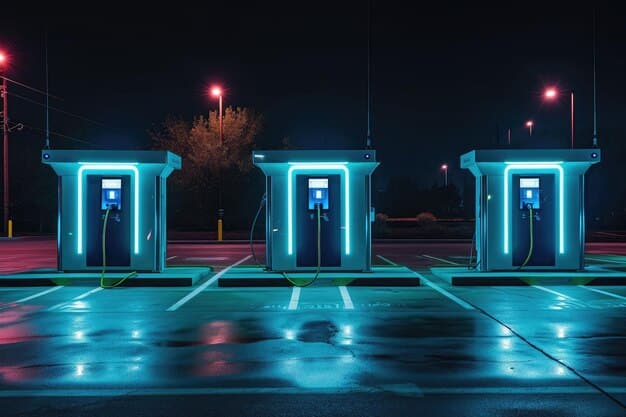The Future of Transportation: Will Electric Vehicles Dominate by 2035?

The future of transportation suggests a significant shift towards electric vehicles, with many analysts predicting their market dominance by 2035, driven by technological advancements, environmental regulations, and evolving consumer preferences.
The question of whether electric vehicles will dominate the market by 2035 is not merely a technical curiosity but a pivotal inquiry shaping our environmental, economic, and social landscapes. Decades of internal combustion engine (ICE) supremacy are facing an unprecedented challenge, fueled by mounting climate concerns, rapid technological innovation, and shifting consumer priorities.
The Road Ahead: Projections and Growth Trajectories
Understanding the potential for electric vehicle (EV) dominance by 2035 requires a deep dive into existing projections and the remarkable growth trajectories observed in recent years. What once seemed like a niche market is rapidly expanding, spurred by a confluence of technological advancements, policy support, and increasing consumer awareness.
The journey towards widespread EV adoption began subtly, but it has gained significant momentum. Early EV models often faced skepticism regarding range anxiety, charging infrastructure, and initial costs. However, continuous innovation has systematically addressed these concerns, transforming EVs from a futuristic concept into a practical, everyday reality for millions globally. The exponential growth seen in EV sales figures isn’t just a fleeting trend; it reflects fundamental shifts in the automotive industry and consumer behavior.
Key Drivers of EV Growth
Several factors are propelling the EV market forward at an accelerating pace. These drivers are multifaceted, encompassing technological, economic, and regulatory dimensions, each playing a crucial role in shaping the transportation landscape.
- Technological Advancements: Significant improvements in battery energy density, charging speeds, and electric motor efficiency have made EVs more competitive with their ICE counterparts.
- Decreasing Costs: While initial purchase prices can still be higher for some EV models, the total cost of ownership (TCO) is increasingly favorable due to lower fuel (electricity) costs, reduced maintenance, and various government incentives.
- Policy and Regulatory Support: Governments worldwide are implementing stringent emission standards, offering tax credits, subsidies, and developing charging infrastructure, creating a conducive environment for EV adoption.
The interplay of these factors creates a powerful feedback loop, where increased adoption leads to further investment in research and development, which in turn drives down costs and improves performance, thereby accelerating adoption even further. Forecasts from leading research firms and automotive manufacturers consistently point towards a significant increase in EV market share, with some predicting that new EV sales could surpass ICE vehicles well before 2035 in key markets.
While the path to dominance isn’t without its challenges, the trajectory is clear. The foundational elements — technological maturity, cost competitiveness, and supportive policies — are firmly in place, paving the way for EVs to potentially redefine what constitutes the mainstream in transportation by the mid-2030s. This transformation isn’t confined to passenger vehicles; it extends to commercial fleets, public transport, and even long-haul trucking, suggesting a comprehensive overhaul of the transport sector.
Battery Breakthroughs and Charging Infrastructure
The heart of an electric vehicle lies in its battery, and the arteries of its practicality are the charging networks. The rapid evolution in both these areas is paramount to any discussion of EV dominance by 2035. Without significant advancements and robust infrastructure, even the most appealing EV designs would remain limited.
Historically, “range anxiety” was a primary barrier to EV adoption. Early battery technologies offered limited range, making long-distance travel impractical for many. However, the past decade has witnessed a revolution in battery chemistry and manufacturing, leading to substantial improvements in energy density, power output, and lifespan. Lithium-ion batteries, though still dominant, are constantly being refined, with research into solid-state batteries and other chemistries promising even greater leaps in the near future.
Innovations in Battery Technology
The pace of battery innovation is relentless, driven by massive investments from both established automakers and dedicated technology companies. These advancements are not just about more mileage; they encompass safety, durability, and a greener lifecycle.
- Increased Energy Density: Modern EV batteries pack more power into smaller, lighter packages, translating to longer driving ranges and more interior space for vehicles.
- Faster Charging Capabilities: New battery designs and charging protocols enable significantly quicker charging times, reducing the inconvenience associated with refueling.
- Enhanced Durability and Lifespan: Batteries are designed to withstand numerous charge cycles, often lasting for the entire life of the vehicle, with potential for second-life applications in energy storage.
Parallel to battery innovation, the expansion and sophistication of charging infrastructure are critical. A fragmented or insufficient charging network can severely impede EV adoption, regardless of how advanced the vehicles themselves become. Governments, private companies, and utilities are investing heavily in building out a comprehensive ecosystem of charging solutions, from public fast chargers to home wallboxes.

The future of charging isn’t just about more stations; it’s about smarter, more integrated solutions. This includes ultra-fast DC charging networks capable of adding hundreds of miles of range in minutes, widespread AC charging at workplaces and residential complexes, and even pilot programs for inductive (wireless) charging and battery swapping technologies. The goal is to make refueling an EV as convenient, or even more convenient, than filling up a traditional gasoline car.
The synergy between battery breakthroughs and charging infrastructure development forms a powerful combination. As batteries become more efficient, requiring less frequent charging, and as charging points become more ubiquitous and faster, the perceived hurdles to EV ownership continue to diminish. By 2035, it’s not unreasonable to expect a charging ecosystem that is as robust and accessible as the current network of gas stations, if not more so, solidifying the foundation for EV market dominance.
Environmental Imperatives and Policy Tailwinds
The push for electric vehicles is not solely driven by technological progress or economic viability; it is deeply intertwined with global environmental imperatives and a rapidly evolving landscape of governmental policies. Addressing climate change and reducing air pollution have become urgent priorities, and transportation remains a significant contributor to both.
The scientific consensus regarding the impact of fossil fuel combustion on global warming and air quality is clear. Exhaust emissions from internal combustion engine (ICE) vehicles release greenhouse gases like carbon dioxide (CO2) and pollutants such as particulate matter and nitrogen oxides, contributing to climate change and respiratory diseases, particularly in urban areas. This undeniable link has galvanized governments and international bodies to enact policies promoting cleaner alternatives.
Global Policy Shifts Towards EVs
From incentives to outright bans, governments are employing a range of policy instruments to accelerate the transition to electric mobility. These policies provide critical tailwinds for the EV market, significantly shaping consumer choices and manufacturer strategies.
- Emissions Regulations: Increasingly stringent CO2 emission targets for vehicle manufacturers compel them to produce more EVs to meet compliance requirements.
- Purchase Incentives and Subsidies: Many countries offer tax credits, rebates, and grants to reduce the upfront cost of EVs, making them more attractive to consumers.
- Infrastructure Investment: Governments are allocating substantial funds to build out public charging networks, addressing a key adoption barrier.
Beyond direct incentives, some municipalities and nations are introducing more aggressive measures. Bans on the sale of new ICE vehicles by a specific date are becoming more common, signaling a clear policy direction. For example, several European countries and states within the US have announced plans to phase out new gasoline car sales by 2030 or 2035, sending a strong signal to both consumers and manufacturers about the inevitability of the shift.
These policy interventions work in tandem with growing public environmental awareness. Consumers are increasingly factoring in environmental impact when making purchasing decisions, and EVs offer a tangible way to reduce individual carbon footprints. The notion of “green transportation” is moving from a niche concern to a mainstream expectation, particularly among younger generations who will be car buyers in 2035.
The intersection of environmental urgency and proactive policy-making creates a powerful force for change. As 2035 approaches, it is highly probable that the regulatory environment will become even more stringent regarding ICE vehicles, while simultaneously expanding support for EVs. This consistent policy pressure, combined with the vehicles’ improving performance and declining costs, suggests a market landscape where electric vehicles are not just an alternative, but the preferred, and in some cases, the only, viable option.
The global commitment to decarbonization and cleaner air makes it highly likely that policy will continue to be a dominant force driving EV adoption, ultimately positioning them for market dominance.
Economic Realities: Costs, Maintenance, and TCO
While environmental benefits and technological allure are significant, the ultimate widespread adoption of electric vehicles hinges on their economic viability. For many consumers and fleet operators, the total cost of ownership (TCO) is a critical determinant. By 2035, the economic case for EVs is expected to be overwhelmingly stronger than it is today.
In the past, the higher upfront purchase price of EVs was a significant deterrent. However, this gap is rapidly closing. The cost of EV batteries, the most expensive component, has plummeted dramatically over the last decade and is projected to continue its downward trend. As production scales increase and battery chemistry improves, the manufacturing cost of EVs will approach, and in some segments, even undercut, that of comparable internal combustion engine (ICE) vehicles.
Total Cost of Ownership (TCO) Advantages
Beyond the sticker price, the operational and maintenance costs of EVs offer substantial long-term savings, which contribute significantly to a lower TCO. These savings accumulate over the vehicle’s lifespan, making EVs a more economical choice in the long run.
- Lower Fuel Costs: Electricity is generally cheaper per mile than gasoline, and charging at home, especially during off-peak hours, can further reduce energy expenses. Public charging networks are also becoming more competitive.
- Reduced Maintenance: EVs have fewer moving parts than ICE vehicles – no engine oil changes, spark plug replacements, or complex transmission systems. This translates to significantly lower routine maintenance costs and reduced frequency of servicing.
- Incentives and Tax Breaks: Various government incentives, such as tax credits for EV purchases and charging infrastructure, and rebates for replacing older, less efficient vehicles, further lower the effective cost of ownership.
Another economic factor is the resale value. As EV technology matures and batteries prove their longevity, the resale market for used EVs is expected to stabilize and grow. A strong secondary market will further enhance the economic appeal for initial buyers, as they can expect to recoup a considerable portion of their investment.
Consider also the economic implications for commercial fleets. Businesses operating vans, buses, and trucks are increasingly recognizing the substantial fuel and maintenance savings offered by electric alternatives. For high-mileage vehicles, these savings can offset the higher upfront cost relatively quickly, leading to improved operational efficiency and profitability. Moreover, some cities are implementing low-emission zones, imposing fees or restrictions on ICE vehicles, which further incentivizes fleet electrification.
By 2035, with battery costs continuing to fall, production efficiencies improving, and a mature charging infrastructure, the economic attractiveness of EVs will likely be undeniable. The combination of lower TCO, government incentives, and environmental benefits will shift consumer preference and business investment decisively towards electric transportation, solidifying its market dominance.
Market Shifts and Consumer Acceptance
The transformation of the automotive market is not just about technology or policy; it’s fundamentally about people. For electric vehicles to dominate by 2035, a seismic shift in consumer perceptions, preferences, and acceptance must solidify. This shift is already well underway, moving beyond early adopters to reach the mainstream.
Initially, EVs were often perceived as niche products, potentially lacking in performance or convenience compared to their gasoline counterparts. However, contemporary EV models have systematically dismantled these misconceptions. Modern EVs often boast instant torque (leading to rapid acceleration), a quieter ride, and a smoother driving experience. These performance advantages, coupled with improved range and charging options, make EVs genuinely competitive, if not superior, in various aspects of driving pleasure.
Evolving Consumer Priorities
Consumer priorities are evolving beyond mere utility. Factors like environmental impact, brand image, and the integration of advanced technology are playing increasingly significant roles in purchasing decisions.
- Performance and Driving Experience: The instant torque and smooth acceleration of EVs appeal to a broad spectrum of drivers, offering a compelling driving experience.
- Environmental Consciousness: A growing segment of consumers prioritizes sustainability, viewing EV ownership as a tangible way to reduce their carbon footprint and support cleaner air.
- Technological Integration: EVs often come equipped with state-of-the-art infotainment systems, advanced driver-assistance features, and over-the-air software updates, appealing to tech-savvy buyers.
The diversification of EV models is also a critical factor. What began mainly with sedans and compact cars has expanded to include electric SUVs, trucks, and even sports cars. This broader availability ensures that almost every vehicle segment has a compelling electric option, catering to a wider range of consumer needs and preferences. The entry of traditional automotive giants and innovative startups into the EV space has intensified competition, leading to faster product development and more diverse offerings.

Furthermore, the social aspect of EV ownership is gaining traction. As more people adopt EVs, there’s a snowball effect, where familiarity breeds acceptance. Neighbors, friends, and family members seeing and experiencing EVs firsthand helps demystify the technology and build confidence in its practicality. Dealership experiences are also improving, with sales staff becoming more knowledgeable about EVs, and charging infrastructure becoming a more visible part of urban and highway landscapes.
By 2035, it’s anticipated that “range anxiety” will be largely a concern of the past, charging will be ubiquitous, and the initial purchase price gap will be negligible. The combination of superior driving characteristics, increasing model diversity, strong environmental credentials, and a reinforcing social acceptance will solidify electric vehicles not just as an alternative, but as the dominant and preferred choice for the majority of consumers.
Challenges and Hurdles on the Path to Dominance
While the momentum behind electric vehicles is undeniable, achieving true market dominance by 2035 is not without its significant challenges. Recognizing and addressing these hurdles is crucial for a smooth and sustainable transition to an electrified transportation future.
One of the persistent concerns is the robustness and accessibility of the charging infrastructure. While investments are pouring in, ensuring universal coverage, particularly in rural areas, apartment complexes, and public spaces, remains a formidable task. The sheer scale required to support millions of EVs will test the capacity of current electrical grids and necessitate smart charging solutions to manage demand effectively.
Key Obstacles to Overcome
Several interconnected challenges need strategic and collaborative efforts from governments, industry, and consumers to be effectively mitigated.
- Grid Preparedness and Energy Supply: The electrical grid needs significant upgrades and potential expansion of renewable energy sources to handle the increased demand from widespread EV charging.
- Global Supply Chains for Materials: The rapid scale-up of EV production relies on critical minerals like lithium, cobalt, and nickel, raising concerns about mining practices, geopolitical stability, and sustainable sourcing.
- Initial Purchase Cost and Affordability: Despite falling battery costs, the upfront price of EVs can still be a barrier for a segment of the population, particularly in developing markets or for lower-income households.
Another area of concern revolves around battery production and recycling. The ethical sourcing of materials, the environmental impact of mining, and the development of efficient, scalable battery recycling processes are vital to ensure that the “green” promise of EVs extends to their entire lifecycle. Without robust recycling, the environmental benefits could be partially offset by waste management challenges.
Furthermore, consumer education remains important. While many misconceptions have been dispelled, some potential buyers still harbor outdated ideas about EV performance, range, and reliability. Effective communication and widespread public awareness campaigns are necessary to ensure that accurate information reaches all segments of the population. The secondhand EV market also needs to mature, providing affordable options and instilling confidence in battery longevity for subsequent owners.
Regulatory frameworks also need to adapt swiftly. This includes not just emissions standards and incentives, but also uniform charging standards, battery disposal regulations, and incentives for charging infrastructure deployment by businesses and individuals. International coordination on these fronts would further accelerate the transition.
Despite these challenges, the industry is actively working to overcome them. Billions are being invested in grid upgrades, battery recycling technologies are advancing, and supply chains are being diversified. While it won’t be a seamless ride, the concerted efforts suggest that these hurdles, though significant, are not insurmountable and are unlikely to derail the overall trajectory towards EV dominance by 2035.
The 2035 Outlook: A New Era of Mobility
As we cast our gaze forward to 2035, the landscape of transportation is poised for a profound transformation, with electric vehicles at its vanguard. The confluence of technological breakthroughs, environmental mandates, economic incentives, and shifting societal values creates a powerful impetus for this change. The question is no longer “if” EVs will play a dominant role, but rather the extent of that dominance and the specific characteristics of this new mobility era.
By 2035, one can reasonably anticipate a significant paradigm shift. The internal combustion engine (ICE) vehicle, while perhaps not entirely eradicated, will likely have receded from its current position of supremacy, potentially confined to niche markets, underserved regions, or legacy fleets. The default choice for a new vehicle purchase will increasingly be electric, driven by a combination of superior performance, lower running costs, and a more compelling user experience.
Defining Characteristics of 2035 Mobility
Beyond sales figures, the dominance of EVs will reshape urban planning, energy consumption, and how we interact with transportation. Several defining characteristics will emerge in this new era.
- Ubiquitous Charging: Charging infrastructure will be pervasive, integrated into homes, workplaces, public parking, and major highway networks, making range anxiety largely obsolete.
- Smarter Grids and Renewable Integration: Electrical grids will be highly adapted to EV charging demand, leveraging smart charging and vehicle-to-grid (V2G) technologies, heavily powered by renewable energy sources.
- Diverse EV Offerings: The market will be saturated with a vast array of EV models spanning all segments, from affordable city cars to robust electric trucks and luxurious performance vehicles, catering to every need and budget.
The impact will extend beyond individual vehicle ownership. Public transportation systems will likely be largely electrified, with electric buses and trains forming the backbone of urban mobility. Commercial fleets, from delivery vans to long-haul trucks, will increasingly transition to electric powertrains, driven by economic efficiencies and regulatory pressures in logistics hubs. The concept of “mobility-as-a-service” will also continue to evolve, with shared electric vehicles and autonomous electric shuttles playing a more prominent role, particularly in dense urban environments.
Furthermore, the environmental benefits will become increasingly tangible. Cleaner urban air, reduced noise pollution, and a significant dent in transportation-related greenhouse gas emissions will contribute to healthier communities and a more sustainable planet. This will reinforce positive feedback loops, further encouraging adoption and investment in the EV ecosystem.
While unforeseen challenges may yet arise, the technological maturity, the economic compellingness, and the political will converge to paint a clear picture. The trajectory is set: by 2035, electric vehicles are not just likely to dominate the market; they are poised to usher in a comprehensive new era of mobility that is cleaner, smarter, and ultimately, more sustainable for generations to come. This transition represents one of the most significant industrial shifts of the 21st century, redefining our relationship with personal and public transportation.
| Key Aspect | Brief Outlook by 2035 |
|---|---|
| 🔋 Battery Tech | Significant advancements in energy density and charging speeds, potentially solid-state. |
| 🔌 Charging Network | Widespread and accessible, akin to current gas station density, with ultra-fast options. |
| 💸 Cost of Ownership | EVs expected to have lower TCO than ICE vehicles due to falling costs and incentives. |
| 🌍 Environmental Impact | Cleaner air, reduced noise pollution, and significant reduction in transport emissions. |
Frequently Asked Questions
▼
While electric vehicles are projected to dominate new car sales by 2035, it’s unlikely they will entirely replace gasoline cars. Many existing ICE vehicles will still be on the road. The transition will be substantial, but a complete phase-out worldwide within this timeframe is improbable, often due to regional differences in infrastructure and adoption rates.
▼
Significant investments are being made in upgrading electricity grids and increasing renewable energy generation. Smart charging technologies and vehicle-to-grid (V2G) systems will help manage demand peaks and utilize EVs as temporary energy storage, alleviating potential strain on the grid. This multi-faceted approach is critical for grid stability.
▼
EVs offer several advantages, including lower running costs due to cheaper electricity and reduced maintenance. They also provide instant torque for faster acceleration, a quieter and smoother driving experience, and produce zero tailpipe emissions, contributing to cleaner air and a reduced carbon footprint. Many governments also offer purchase incentives.
▼
While battery production has an environmental footprint, numerous studies suggest that over their lifecycle, EVs generate significantly lower emissions than ICE vehicles, especially when charged with renewable energy. Advances in battery recycling and sustainable material sourcing are continually reducing the environmental impact of battery manufacturing, improving their overall green credentials.
▼
By 2035, ultra-fast DC charging will be widespread, enabling significant range additions in minutes, comparable to a quick gas stop. While home charging provides daily convenience, public charging infrastructure will be significantly denser and more efficient, making charging an EV increasingly convenient and integrated into daily routines, not just a highway-stop activity.
Conclusion
The journey towards an electrified transportation future is accelerating at an unprecedented pace. The answer to whether electric vehicles will dominate the market by 2035 appears to be a resounding “yes,” supported by converging trends in technology, economics, policy, and consumer behavior. While challenges in infrastructure and material sourcing persist, the collective global effort to mitigate climate change and improve urban air quality, coupled with the inherent advantages EVs offer, points towards an undeniable shift. This future promises a cleaner, quieter, and more efficient mobility ecosystem, fundamentally reshaping how we travel and interact with our environment for generations to come. The era of electric dominance is not a distant dream, but a rapidly approaching reality.





